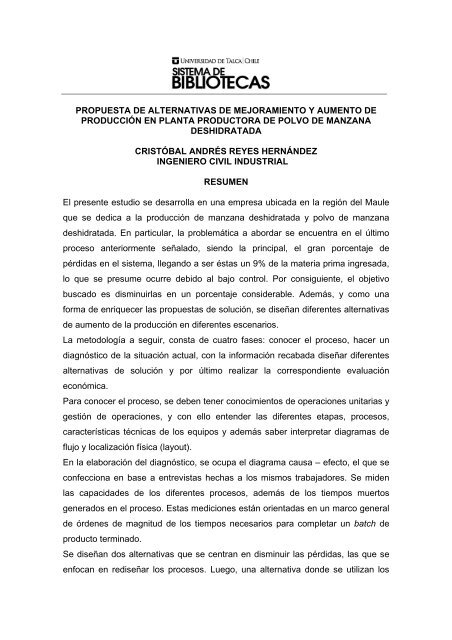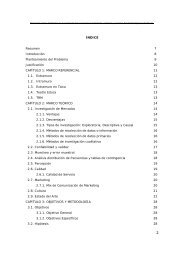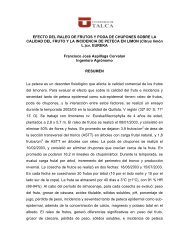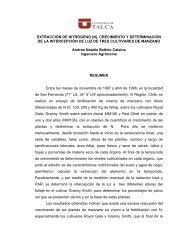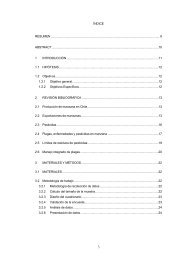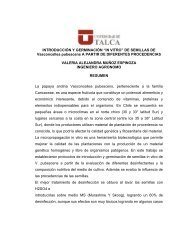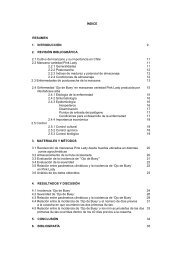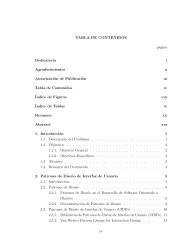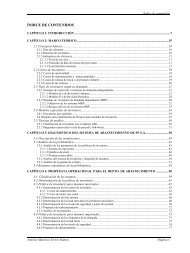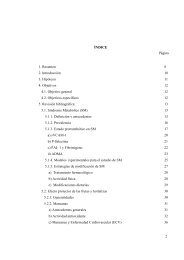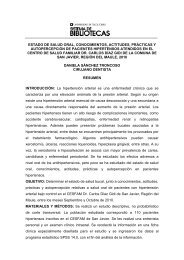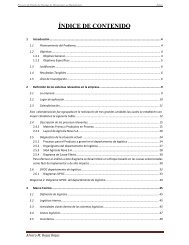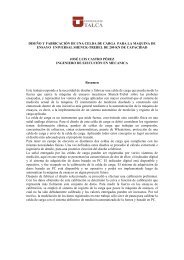propuesta de alternativas de mejoramiento y aumento de ...
propuesta de alternativas de mejoramiento y aumento de ...
propuesta de alternativas de mejoramiento y aumento de ...
Create successful ePaper yourself
Turn your PDF publications into a flip-book with our unique Google optimized e-Paper software.
PROPUESTA DE ALTERNATIVAS DE MEJORAMIENTO Y AUMENTO DEPRODUCCIÓN EN PLANTA PRODUCTORA DE POLVO DE MANZANADESHIDRATADACRISTÓBAL ANDRÉS REYES HERNÁNDEZINGENIERO CIVIL INDUSTRIALRESUMENEl presente estudio se <strong>de</strong>sarrolla en una empresa ubicada en la región <strong>de</strong>l Mauleque se <strong>de</strong>dica a la producción <strong>de</strong> manzana <strong>de</strong>shidratada y polvo <strong>de</strong> manzana<strong>de</strong>shidratada. En particular, la problemática a abordar se encuentra en el últimoproceso anteriormente señalado, siendo la principal, el gran porcentaje <strong>de</strong>pérdidas en el sistema, llegando a ser éstas un 9% <strong>de</strong> la materia prima ingresada,lo que se presume ocurre <strong>de</strong>bido al bajo control. Por consiguiente, el objetivobuscado es disminuirlas en un porcentaje consi<strong>de</strong>rable. A<strong>de</strong>más, y como unaforma <strong>de</strong> enriquecer las <strong>propuesta</strong>s <strong>de</strong> solución, se diseñan diferentes <strong>alternativas</strong><strong>de</strong> <strong>aumento</strong> <strong>de</strong> la producción en diferentes escenarios.La metodología a seguir, consta <strong>de</strong> cuatro fases: conocer el proceso, hacer undiagnóstico <strong>de</strong> la situación actual, con la información recabada diseñar diferentes<strong>alternativas</strong> <strong>de</strong> solución y por último realizar la correspondiente evaluacióneconómica.Para conocer el proceso, se <strong>de</strong>ben tener conocimientos <strong>de</strong> operaciones unitarias ygestión <strong>de</strong> operaciones, y con ello enten<strong>de</strong>r las diferentes etapas, procesos,características técnicas <strong>de</strong> los equipos y a<strong>de</strong>más saber interpretar diagramas <strong>de</strong>flujo y localización física (layout).En la elaboración <strong>de</strong>l diagnóstico, se ocupa el diagrama causa – efecto, el que seconfecciona en base a entrevistas hechas a los mismos trabajadores. Se mi<strong>de</strong>nlas capacida<strong>de</strong>s <strong>de</strong> los diferentes procesos, a<strong>de</strong>más <strong>de</strong> los tiempos muertosgenerados en el proceso. Estas mediciones están orientadas en un marco general<strong>de</strong> ór<strong>de</strong>nes <strong>de</strong> magnitud <strong>de</strong> los tiempos necesarios para completar un batch <strong>de</strong>producto terminado.Se diseñan dos <strong>alternativas</strong> que se centran en disminuir las pérdidas, las que seenfocan en rediseñar los procesos. Luego, una alternativa don<strong>de</strong> se utilizan los
métodos <strong>de</strong> manufactura esbelta 5s y SMED, dando así or<strong>de</strong>n y estandarización alos procesos y procedimientos. Se diseñan puntos <strong>de</strong> control tanto <strong>de</strong> procesoscomo <strong>de</strong> calidad y diversos registros. Para finalizar, se proponen dos escenarios<strong>de</strong> crecimiento <strong>de</strong> la producción, tema que se aborda usando “Teoría <strong>de</strong>Restricciones” (Theory of Constraints).Para concluir, según los escenarios estudiados, es posible disminuir las pérdidasen un mínimo <strong>de</strong> 56%, aumentar la producción hasta un 330%, disminuir lostiempos muertos en un 58% y aumentar los ingresos en un 114% con un alzadiferencial <strong>de</strong> costos <strong>de</strong> $486MM. Abstract Cristóbal Andrés Reyes Hernán<strong>de</strong>z
ABSTRACTThe present study <strong>de</strong>velops at a company located at the Maule's region. Thiscompany <strong>de</strong>dicates the production of <strong>de</strong>hydrated apple and <strong>de</strong>hydrated apple dust.In particular, the problem to aboard find itself in the second mentioned process,being the principal, the great percentage of losses in the system, becoming these9% of the <strong>de</strong>posited raw material, what is presumed happens owed to the un<strong>de</strong>rcontrol. Consequently, the sought-after objective is to <strong>de</strong>crease them in aconsi<strong>de</strong>rable percentage. Besi<strong>de</strong>s, and like a form to enrich the proposals ofsolution, they <strong>de</strong>sign different alternatives of increase of the production at differentscenes. The methodology to follow, consist of four phases: Knowing the process,doing a diagnosis of the present-day situation with the procured information,<strong>de</strong>signing different alternatives of solution and finally accomplishing thecorrespon<strong>de</strong>nt economic appraisal. In or<strong>de</strong>r to know the process, knowledge ofunitary operations and operations management must have themselves, and with itun<strong>de</strong>rstanding the different stages, processes, the teams' technical characteristicsand besi<strong>de</strong>s knowing how to interpret flow diagrams and physical location (layout).In the elaboration of the diagnosis, we occupy the cause-effect diagram, the onethat is manufactured on the basis of interviews done to the same workers. Theymeasure the capabilities of the different processes in addition to the <strong>de</strong>ad timesgenerated in the process. These measurements are gui<strong>de</strong>d in a general frame ofor<strong>de</strong>rs of magnitu<strong>de</strong> of the necessary times to complete a batch of finished goods.They <strong>de</strong>sign two alternatives that focus on easing up losses, the ones that focus onre<strong>de</strong>signing the processes. Next, an alternative where utilize the methods of LeanManufacturing 5s and SMED, giving or<strong>de</strong>r and standardization to the processesand procedures. We <strong>de</strong>sign checkpoints so much of processes seemingly as ofquality and various records. In or<strong>de</strong>r to finalize, they set themselves two scenes ofgrowth of production, subject that is discussed using theory of constraints.In or<strong>de</strong>r to come to an end, according to the scenes studied, it is possible to<strong>de</strong>crease the losses in 56%'s minimum, to increase the production to a 330%, to<strong>de</strong>crease the <strong>de</strong>ad times in a 58% and to increase the entrances in a 114% with adifferential rise of costs of $486MM.


